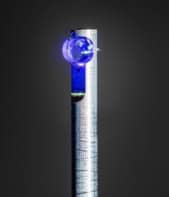
The first holograms of large objects made using neutrons have been unveiled by physicists in the US and Canada. Unlike conventional holograms produced with laser light, neutron-generated holograms can image the interiors of objects. The researchers say these 3D images could be useful in materials science and could even be used in quantum computers of the future.
Beams of neutrons are a good probe of the internal structure of solid objects because they are able to pass through most materials without being completely absorbed. As a result, neutrons can be used to image the interiors of objects that are too large or to dense to be studied with X-rays – which are much more prone to be absorbed or scattered by matter. Dmitry Pushin, a physicist at the University of Waterloo who led the hologram research, explains: “A heavy metal such as lead is very transparent to neutrons.” Neutrons have also been used to image materials such as hydrogen in fuel cells, which are essentially invisible to X-rays. Because neutrons interact with matter differently than X-rays or other electromagnetic radiation, images constructed with neutrons deliver a different perspective on an object than images constructed with photons.
While scientists have used neutrons to create images for several decades – including tiny holograms on the atomic scale – Pushin’s group is the first to create neutron-generated holograms of macroscopic objects. To make their holograms, the researchers used a beam of neutrons generated by a nuclear reactor at the National Institute of Standards and Technology located in Maryland in the US.
Spiral plate
These neutrons are first split into two beams called the object beam and the reference beam, in analogy to the two laser beams used in conventional holography. The object beam then passes through a 1 cm-thick piece of aluminium known as a spiral phase plate. This increases the orbital angular momentum (OAM) of the beam by a specific amount. The object beam is then recombined with the reference beam to form a 3D interference pattern on a detector. This interference pattern is the hologram image of the spiral phase plate and has a spatial resolution on the micron scale.
Pushin says that using neutron holograms to image the spiral phase plate also provides a new way of visualizing the quantum nature of OAM. The team created holograms of several different spiral phase plates that each increased the neutron beam’s OAM by a different quantity. The holograms’ interference patterns resemble zebra stripes and matched computer simulations. These simulations predicted that the hologram’s interference patterns would branch and fork uniquely, depending on the OAM of the object beam (see figure). Because OAM can be used as a way of storing and transmitting quantum information, the holograms could potentially be useful in quantum-information research such as the development of quantum computers.
Topological materials
Pushin anticipates other applications for neutron holography, including studying the internal structure of new materials. In particular, he says the technique could aid in the discovery of topological conductors and insulators.
The next step, Pushin says, is to create more tools such as diffraction gratings, which can manipulate the shape of the neutron beam in more precise ways. The team also plans to start using neutron holography to characterize new materials.
The research is described in Optics Express.



